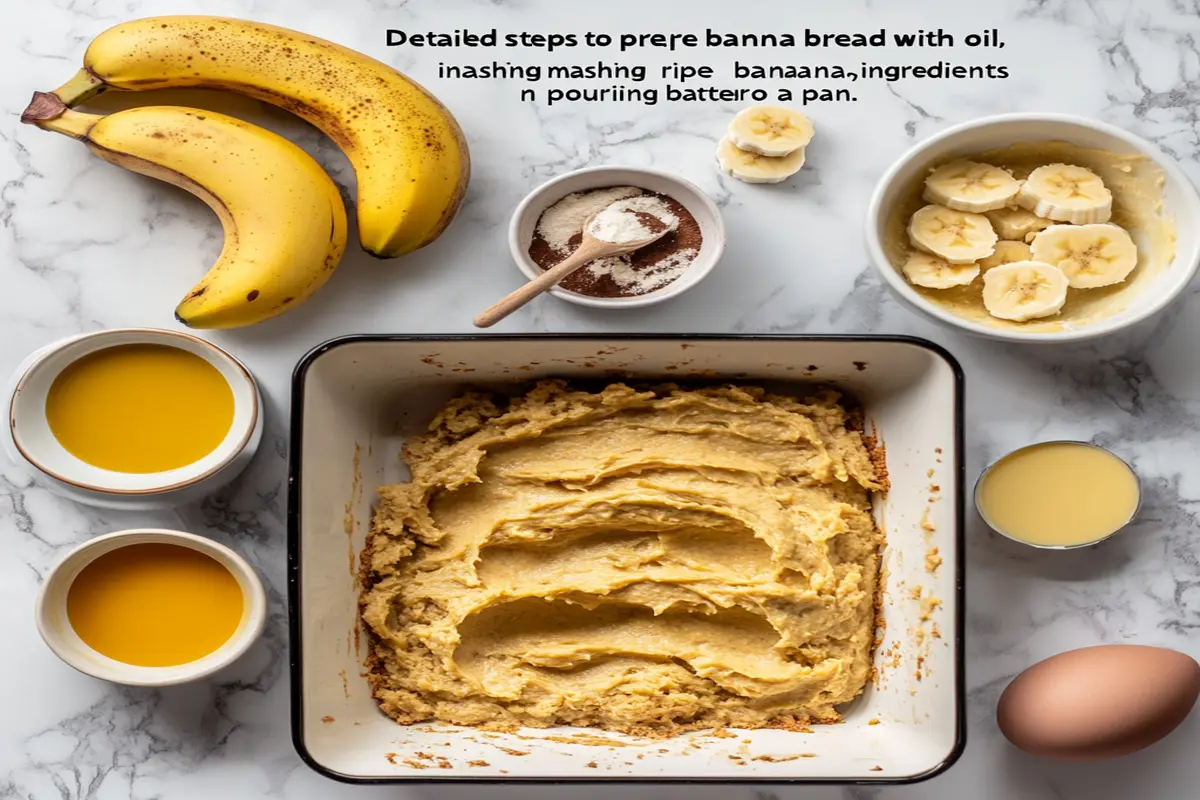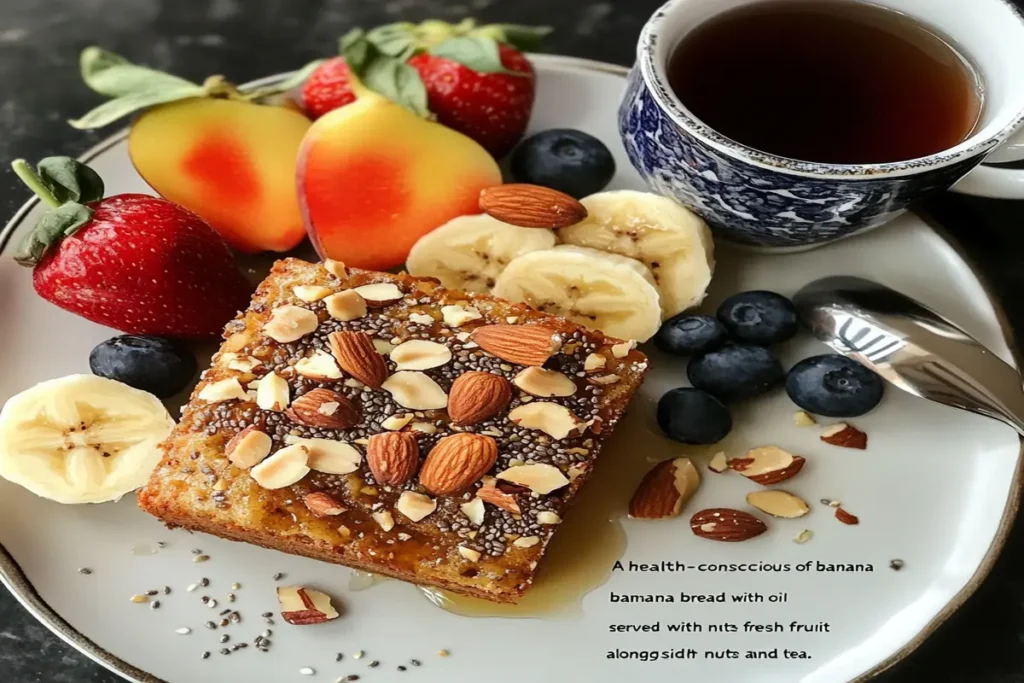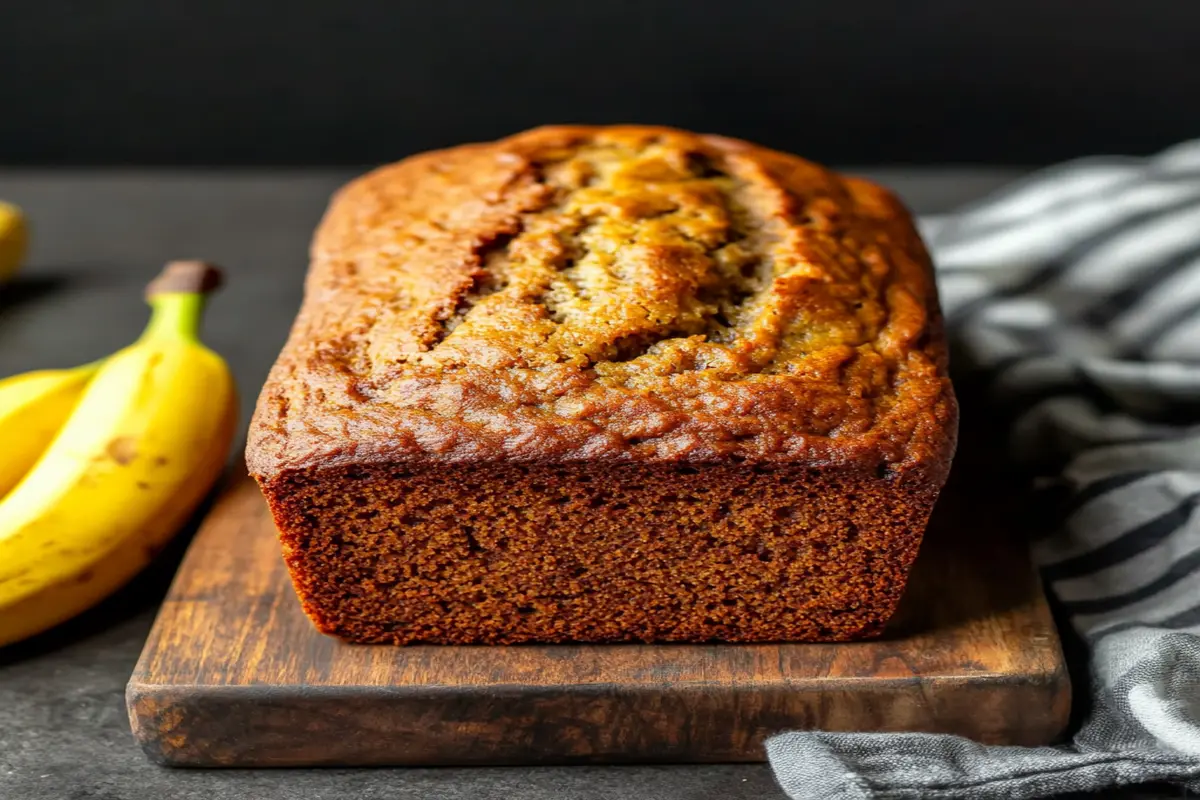Banana bread is a universal favorite—soft, moist, and packed with flavor. But did you know that using oil instead of butter can take your recipe to the next level? Oil-based banana bread recipes are known for their unbeatable texture and rich taste. In this guide, we’ll explore why oil works so well in banana bread, the best oils to use, and how to craft the perfect loaf from scratch. Whether you’re a seasoned baker or a newbie, you’ll find tips, tricks, and FAQs to ensure your banana bread comes out just right every time. Let’s get baking!
Why Use Oil in Banana Bread?
Benefits of Oil vs. Butter
Why swap butter for oil in your banana bread? It’s all about moisture! Unlike butter, which solidifies when cooled, oil remains liquid at room temperature. This means your banana bread stays soft and tender, even after a day or two.
Oil also distributes evenly throughout the batter, ensuring every slice of your banana bread recipe with oil is moist and delicious. Plus, using oil makes the recipe quicker—no need to wait for butter to soften or melt!
And let’s not forget about health benefits. Many oils, like olive or avocado oil, are rich in unsaturated fats, which are better for your heart compared to saturated fats in butter.
Types of Oils for Banana Bread
Choosing the right oil can make or break your banana bread. Here are a few popular options:
- Vegetable Oil: Neutral in flavor and widely available, this is a go-to for classic banana bread.
- Coconut Oil: Adds a subtle, tropical flavor while keeping the bread moist.
- Canola Oil: Another neutral option, perfect if you’re looking for a light texture.
- Olive Oil: A healthier choice that adds a slight fruity undertone to the bread.
Each oil brings its unique flair, so don’t hesitate to experiment! Just remember, strong-flavored oils like extra virgin olive oil can overpower the banana flavor, so use them sparingly.
Essential Ingredients for Oil-Based Banana Bread
Key Ingredients and Their Roles
A good banana bread recipe with oil starts with simple, pantry-friendly ingredients. Each one plays a vital role in creating the moist, flavorful loaf that banana bread lovers crave.
- Bananas: The hero of the recipe! Ripe, spotty bananas are ideal—they’re sweeter and easier to mash.
- Oil: The key to keeping your bread moist. Choose a neutral oil like canola or vegetable, or experiment with coconut oil for a tropical twist.
- Sugar: Granulated sugar works well, but brown sugar adds a richer, caramel-like flavor.
- Eggs: These bind the ingredients together and help the bread rise.
- Flour: All-purpose flour is the standard, but whole wheat or gluten-free options can be used for a healthier spin.
- Baking Soda: This acts as a leavening agent, ensuring your bread is light and fluffy.
These ingredients come together beautifully, creating a batter that’s rich and smooth, ready to bake into the perfect loaf.
Choosing the Right Bananas
Let’s talk bananas—the riper, the better! Spotty or even black bananas may seem past their prime, but they’re actually ideal for banana bread recipes with oil. Their sweetness intensifies as they ripen, bringing out the classic banana flavor in your bread.
If you’re in a hurry and don’t have ripe bananas, try this trick: place bananas on a baking sheet and bake at 300°F for about 15 minutes until the skins darken. Cool before peeling and mashing.
For more inspiration, explore this pumpkin banana loaf recipe, which adds a seasonal twist to the classic banana bread.
Step-by-Step Instructions for Banana Bread Recipe with Oil
Preparing Your Ingredients

Before you start mixing, gather all your ingredients and tools. Preheat your oven to 350°F (175°C) and grease a 9×5-inch loaf pan with a bit of oil or nonstick spray.
- Mash Bananas: In a large bowl, mash 2-3 ripe bananas with a fork or potato masher until smooth.
- Combine Wet Ingredients: Add your oil (about ½ cup), eggs, and sugar to the bananas. Whisk together until well blended.
- Mix Dry Ingredients: In a separate bowl, whisk together flour, baking soda, and a pinch of salt.
Baking Techniques for Success
- Combine Wet and Dry: Slowly add the dry ingredients to the wet mixture, stirring until just combined. Overmixing can lead to dense banana bread, so mix gently!
- Pour and Bake: Pour the batter into your prepared loaf pan. Bake for 50-60 minutes, or until a toothpick inserted in the center comes out clean.
- Cool Before Slicing: Let the bread cool in the pan for 10 minutes, then transfer to a wire rack to cool completely.
This simple banana bread recipe with oil is quick to prepare and guarantees a moist, flavorful loaf every time.
Part 4: Tips for Perfect Oil-Based Banana Bread (350 Words)
How to Make Banana Bread Fluffy
Achieving fluffy banana bread doesn’t have to be tricky, even with an oil-based recipe. The key is in your technique and ingredients.
- Don’t Overmix: Once you combine the wet and dry ingredients, stir just until incorporated. Overmixing develops gluten in the flour, leading to dense bread.
- Use Fresh Baking Soda: Old baking soda loses its potency, so ensure yours is fresh for a good rise.
- Room-Temperature Ingredients: Let your eggs and oil sit at room temperature before mixing. This helps create a smoother batter and better texture.
By focusing on these simple tips, you’ll end up with banana bread that’s airy, moist, and full of flavor.
Common Mistakes to Avoid
Even the best bakers can stumble, so here are common pitfalls to dodge when making a banana bread recipe with oil:
- Using Unripe Bananas: If your bananas aren’t soft and sweet, your bread will lack the rich banana flavor it’s known for.
- Incorrect Measurements: Use a kitchen scale or proper measuring tools for accuracy. Too much flour or oil can throw off the balance.
- Rushing the Baking Time: Resist the urge to remove the bread before it’s fully baked. A toothpick inserted in the center should come out clean.
For more detailed baking tips, consider visiting pumpkin banana loaf tips for insights that apply to banana bread too.
Variations on the Classic Recipe
Adding Mix-Ins
Take your banana bread recipe with oil up a notch with some creative add-ins! Here are a few ideas to personalize your loaf:
- Chocolate Chips: Add ½ cup of semisweet chocolate chips for a sweet, indulgent twist.
- Nuts: Walnuts or pecans provide a satisfying crunch that pairs beautifully with banana bread.
- Dried Fruits: Raisins or cranberries add a pop of tartness to balance the sweetness.
Simply fold these extras into your batter after mixing the wet and dry ingredients.
Alternative Flavors
If you’re feeling adventurous, why not experiment with the flavor profile of your banana bread?
- Spices: Add a teaspoon of cinnamon or nutmeg to infuse warm, cozy notes.
- Alternative Flours: Swap some of the all-purpose flour for almond or whole wheat flour to enhance the nutritional value.
- Sweeteners: Replace some of the sugar with honey or maple syrup for a natural sweetness.
By tweaking the ingredients slightly, you can craft a version of banana bread that’s uniquely yours while still retaining the moist texture provided by oil.
For more ideas to elevate your recipes, check out this site’s other baking tips and tricks. There’s always room to get creative in the kitchen!
FAQs About Banana Bread Recipe with Oil
What Is the Best Oil to Use When Making Banana Bread?
The best oil for a banana bread recipe with oil depends on your taste preferences and dietary needs. For a neutral flavor, vegetable oil or canola oil works perfectly. If you want to add a hint of sweetness, coconut oil is a fantastic choice. Olive oil is another healthy alternative, though its slightly fruity taste might change the flavor of your bread.
No matter which oil you choose, it’s important to use high-quality, fresh oil to maintain the bread’s rich taste and soft texture.
What Is the Formula for Banana Bread?
A classic formula for banana bread balances wet and dry ingredients to ensure a moist but firm texture. Here’s a simple ratio for success:
- Wet ingredients: Bananas, oil, eggs, sugar, and any liquids like vanilla extract.
- Dry ingredients: Flour, baking soda, and a pinch of salt.
For every cup of mashed bananas (about 2-3 medium bananas), use ½ cup of oil and 1½ cups of flour. This balance ensures the bread stays moist without being overly dense.
Why Did My Banana Bread Not Come Out Fluffy?
If your banana bread didn’t turn out fluffy, several factors could be to blame:
- Overmixing: Too much mixing develops gluten, resulting in a denser loaf.
- Old Baking Soda: Ensure your leavening agents are fresh for the best rise.
- Incorrect Ratios: Too much flour or too little oil can affect the texture.
Can Bananas Be Too Ripe for Banana Bread?
Not at all! In fact, the riper, the better. Overripe bananas with black spots on their skins have the best sweetness and flavor for banana bread. However, if they’ve started fermenting or have a sour smell, they’re past their prime.
Storing and Serving Banana Bread
How to Store Banana Bread for Freshness
Proper storage is key to keeping your banana bread recipe with oil moist and flavorful. If you plan to eat it within a couple of days, wrap it tightly in plastic wrap or aluminum foil and store it at room temperature.
For longer storage, place the wrapped bread in an airtight container and refrigerate for up to a week. To enjoy it later, freeze slices individually for quick thawing. Just let them sit at room temperature for 30 minutes, or pop them in the microwave for a few seconds.
Serving Suggestions
Banana bread is delicious on its own, but you can elevate your experience with a few simple additions:
- Spreads: Add a layer of butter, cream cheese, or Nutella for extra indulgence.
- Pairings: Serve with a cup of coffee, tea, or a glass of milk for a comforting snack.
- Toppings: Sprinkle powdered sugar or drizzle a bit of honey for a sweet finish.
With its incredible versatility and lasting freshness, banana bread is the perfect treat for any occasion.
Healthier Alternatives for Banana Bread with Oil
Using Healthier Oils

When crafting a banana bread recipe with oil, opting for healthier oils can make your loaf both delicious and nutritious. Olive oil, particularly light olive oil, is a fantastic substitute for traditional vegetable oil. It adds healthy fats while keeping the bread moist. Avocado oil is another excellent choice due to its mild flavor and heart-healthy properties.
If you want to reduce the oil content altogether, you can replace half of the oil with unsweetened applesauce. This keeps the bread moist while lowering its calorie count, making it perfect for those watching their intake.
Reducing Sugar or Adding Nutrients
For a healthier version of banana bread, consider reducing the sugar by substituting part of it with natural sweeteners like honey or maple syrup. These alternatives not only lower refined sugar content but also add unique flavors to your bread.
To boost nutrition, mix in ingredients like flaxseeds, chia seeds, or even a scoop of protein powder. Whole wheat flour can replace part or all of the all-purpose flour, enhancing the fiber content without compromising the bread’s structure.
By combining healthier oils and nutrient-rich ingredients, you can enjoy a guilt-free version of this classic treat.
Final Thoughts and Takeaways
Why Banana Bread with Oil is a Game-Changer
If you’ve ever wondered, What is the formula for banana bread?—you now know that using oil is a simple, transformative tweak. Oil ensures your banana bread stays moist, fluffy, and rich in flavor, making it a reliable choice for both beginner and experienced bakers. Whether you prefer classic vegetable oil or experiment with coconut or olive oil, the results are bound to impress.
Embrace Versatility
What sets banana bread apart is its incredible versatility. You can customize the recipe with mix-ins, alternative sweeteners, or healthier substitutions, making it suitable for any taste or occasion. From breakfast to dessert, this adaptable bread fits seamlessly into any menu.
For more delicious ideas, consider pairing banana bread with spreads, warm beverages, or fresh fruit to elevate its flavor profile. If you’re still curious about different recipes, check out similar options on the site for inspiration.
By following this guide, you’ll be well-equipped to bake a loaf that’s perfectly moist, rich in banana flavor, and delightfully easy to make. So, grab those ripe bananas and start baking your next masterpiece!

